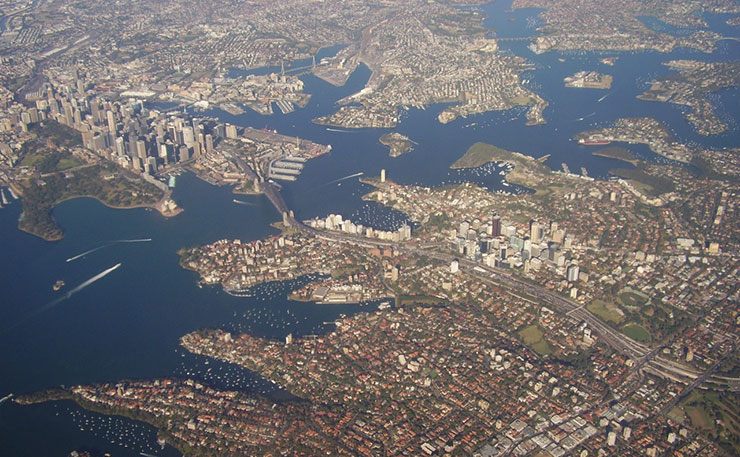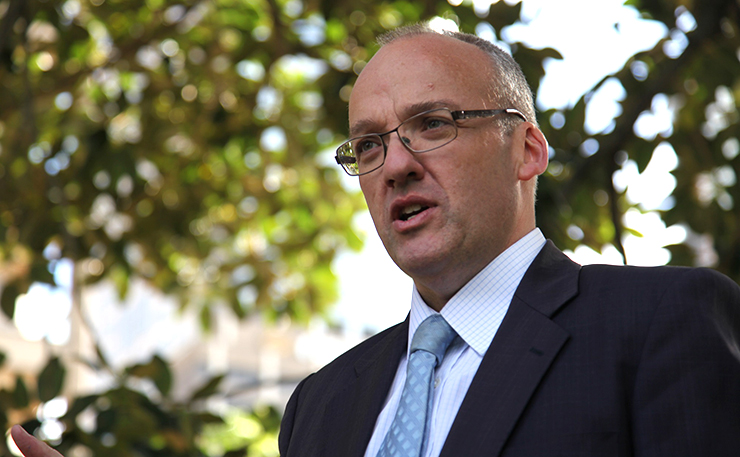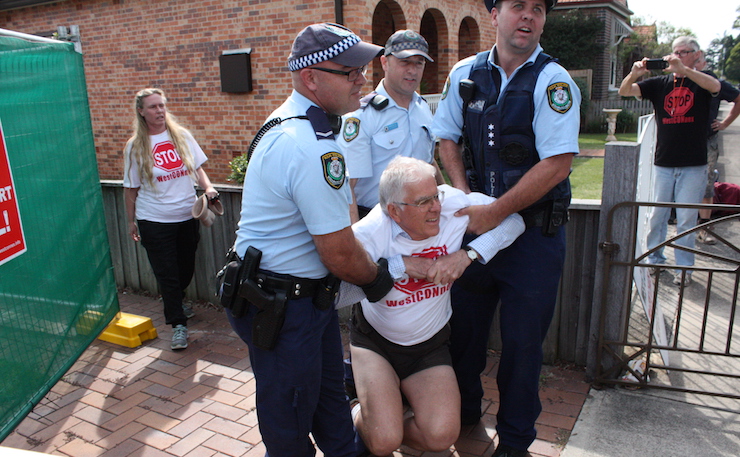The two major parties in NSW are more or less in lock-step on one of the nation’s largest and most controversial infrastructure projects, writes Julie Macken*. That doesn’t leave voters a lot of choice.
With less than two weeks to go before the NSW State election, communities across Sydney know the window of opportunity to stop Australia’s most expensive infrastructure program is closing – it’s a minute to midnight for thousands of Sydneysiders.
Obfuscation and misinformation has made it extremely difficult for those living in the path of this juggernaut to know what the major parties plan to do should they gain power after March 23. It is time to put the evidence on the table to ensure people get to vote with the full facts.
The WestConnex project has created history in Australia and internationally for three reasons.
First, it is one of the most expensive infrastructure projects ever undertaken in Australia – while firm figures are hard to find it is now estimated to be costing over $17billion, with some estimates putting it at closer to $20 billion and it’s only half completed.
Secondly, and related to the first, it is “the worst example of a lack of transparency,” according to the Chair of the NSW Inquiry into WestConnex, Reverend Fred Nile, of the Christian Democrats.
The NSW Inquiry into WestConnex findings included the following:
- The NSW Government was not required to consider the full range of costs in the business case for the WestConnex project, including costs to public health, amenity, biodiversity, extra road building, and losses to public transport.
- The NSW Government failed to adequately consider alternative options at the commencement of the WestConnex project. This failure has undermined the justification for the project and has exacerbated community opposition.
- The transparency arrangements pertaining to the WestConnex business case have been unsatisfactory.
- The delivery of the WestConnex project by Sydney Motorway Corporation has weakened the accountability and disclosure rules that would have otherwise applied if the project had been delivered by a government agency, including the important provisions of the Government Information (Public Access) Act 2009.
Thirdly, the contractors are using tunnelling techniques not used anywhere in the world to create tunnels over 8km long. These techniques may see motorists exposed to extremely dangerous levels of carcinogenic pollutants like PM2.5.

While communities in Haberfield and St Peters are deeply alarmed by the dangerous levels of air pollution their kids are exposed to even in the construction phase, Dr Noel Child, an experienced scientist and engineer, and previous reviewer of international air treatment technologies for the then Road Transport Authority of NSW (RTA), has serious concerns about the risk future motorists confront by using these tunnels.
In his submission to the NSW Inquiry he highlights the risk posed by the use of the “piston method” for ventilating these extremely long tunnels and believes it could expose motorists to high levels of dangerous air pollutants including PM 2.5.
He notes:
“That method relies on traffic flowing through the tunnel and pulling the current of air pollutants with them as they go. What happens when traffic slows or stops, what happens when there’s an accident in the tunnel and the air is not being pulled through by traffic flows? What happens is the motorists are sitting in a cocktail of toxic air and not even the car cabin will protect them from exposure. That’s why across the world engineers ensure every 3km there is total replacement of the air – this isn’t happening in the WestConnex tunnels.”
Dr Child concluded telling me, “People are concerned about pollution impacts from stack emissions, and so they should be. But installing the right sort of ventilation systems in these long, busy tunnels is also very important. It is vitally important, both within the tunnels and near the stacks, that air quality is maintained. I’ve seen nothing to convince me that this aspect of the project has been properly thought through – and if it hasn’t, we will be playing dice with people’s health.”
A state secret
Just as the project has been shrouded in secrecy and misinformation, trying to get a clear idea of what the major political parties are committing to in terms of its future is as clear as mud. But with the State election just weeks away and a federal election in May, now is the time to get crystal clear about what the major parties are proposing in relation to WestConnex and the communities that lie in its path.
I began reporting on the first iteration of this project in June 2005, when working for The Australian Financial Review I reported the following story:
‘The NSW government plans to revive its inner western suburbs road upgrade plans but divert them south as a longer connection towards the proposed upgrade at Port Botany freight centre.
Rather than just linking the M4 East motorway extension with Sydney suburbs like Strathfield and Haberfield, the toll road is expected to go to Anzac Bridge and head south towards Port Botany and Sydney airport.
But it will not be announced until after a feasibility study being undertaken by former federal Labor minister Laurie Brereton is released in late July.
The plan for Port Botany also involves having rail and road hubs at Enfield close to one of the options for the link to Port Botany and Moorebank further to the northwest.
The $2 billion-plus motorway extension is expected to be longer than previous proposals and the Carr government set aside about $500,000 in the recent state budget for planning work on the road.
While the government withdrew the M4 East motorway plan in April amid fears of a resident backlash in upmarket Haberfield, Labor MP Eric Roozendaal has told the NSW Road Transport Association that the state government has not shelved what has been billed as the missing link in Sydney’s road transport network.
“I can assure [you]the NSW government has not shelved the M4 East,” Mr Roozendaal said on Friday. “The NSW government will now deliver an M4 East motorway extension as a vital link for Sydney as part of the Sydney Metropolitan Strategy.”
In 2005 those communities did organise and successfully saw off this proposal. However as this article in the SMH reveals, by 2009 Labor was once again pushing forward with project.
‘SECRET plans for a $10 billion tollway underneath the inner city are still being developed by the State Government despite a $2 billion budget deficit and evidence the monster road network will only worsen congestion across Sydney.
Vast underground intersections are being planned for heritage suburbs such as Glebe, Rozelle Bay and Haberfield, requiring a string of exhaust ventilation stacks.’
Since then this project has grown in ambition, scale, costs and coverage and along the way both Labor and the Coalition have supported it while the NSW Greens have opposed it every step of the way.
Which brings us to the current state of affairs.
The Coalition’s position is unchanged despite the findings of the Parliamentary Inquiry and the difficult state of some of the contractors, such as Lend Lease, used by the Berejiklian government to carry out sections of the work. Having lost $500 million on Northconnex, Lend Lease is selling its engineering division even as they embark on another tunnel project – one that may go as shallow as 13-metres under some houses. The Coalition are committed to building the entire project that includes the massive Rozelle interchange and the harbour tunnel that will run under Balmain to the North Shore – all 33km.

Furthermore, they have no intention of changing any of the conditions or introducing what they consider to be “costly” filtration of the air pollution stacks that will funnel the pollutants from thousands of cars daily.
Nor is the Berejiklian government swayed by headlines that show Sydney has the highest transport costs of any city in Australia and the most tolled roads, most of which are operated by the country’s biggest toll road company, Transurban. Or by the fact that the average Sydney household spends $82.20 on tolls each week, well above the $51.10 spent by Brisbane households and the $49.20 spent by Melbourne households.
The NSW Greens position is equally clear. That party is committed to stopping WestConnex in its tracks, not going ahead with Stage 3 including the Rozelle Interchange, nor the harbour tunnel, insisting any air pollution stacks be capped and communities compensated for the damage already done to their properties.
In 2011, the Greens won the seat of Balmain off Labor, with Jamie Parker becoming the first Greens MP to win a lower house seat. Parker told The Australian recently, WestConnex was the number one issue for voters and a 30m-high exhaust stack slated to be built in Rozelle next to a primary school had enraged many in the area.
“I’ve spoken with people who are distressed because their homes will be acquired and parents who have their child’s school right next to an exhaust stack,” he said.
The NSW Greens have vowed to “reverse” those aspects of the WestConnex development that were in their early stages, such as the Rozelle interchange.
But what of Labor? Depending on whom you talk to Labor’s policy on WestConnex is not so clear, although there appears to be four major differences between the ALP and the Coalition.

The first difference is they have committed to providing a cash-back for motorists who use the tollway, first announced by Luke Foley in 2018. This may be good politics but as Jake Saulwick pointed out recently in the SMH.
‘Under Labor, in other words, the state will soon be paying more than $300 million a year – and climbing – to subsidise toll roads. That is money that would not be spent on all the things on which Labor says money should be spent – schools and hospitals before stadiums and all that.
Labor’s policy is also an absurdly generous free kick to one company. It would have been one thing to promise cash back on the M4 section of WestConnex before the government sold 51 per cent of it. But Labor is retaining that position even when it means that those hundreds of millions of refunded tolls will be funnelled directly from taxpayers to Transurban.’
Secondly, they will not build the harbour tunnel crossing from Balmain to the North Shore, or rather; they will not build 40% of that project, a situation now seen by many as a deferral of the project rather than a refusal to build it. They are still committed to building the massive Balmain/Rozelle interchange that will bring the pollution stacks referred to by Jamie Parker, and the tunnelling that has created so much damage in Haberfield and elsewhere.
Thirdly they have not ruled out filtering the pollution stacks but have said they will be “guided by the science”.
Finally Labor has promised a judicial inquiry into WestConnex if it wins on the 23rd March. This is an interesting development because, although while lacking the powers of a Royal Commission, the inquiry has the potential to reveal any corrupt practices that could have had a major role in securing approval for WestConnex.
If this were the case, then cancelling the Balmain/Rozelle interchange would not be the financial disaster Labor’s candidate in Balmain, Elly Howse, argues it would be. She told The Australian newspaper recently:
“When people ask me if I’ll stop WestConnex if they vote for me, I say ‘no’ because the project is over half-complete and a responsible government has to complete projects that we sometimes don’t agree with,” adding, “To untangle the construction contracts and tolling contracts that have been set up for the next 43 years, we’re talking about billions and billions of dollars,” she said.
Of course untangling contracts is what many lawyers do for a living. The question is not, ‘can this contract be broken’ but rather, ‘how much compensation would the people of NSW pay if the contract were broken?’ If the judicial inquiry established by Labor were to uncover any foundational documents were faulty the contract itself would come into question.
At this stage punters are unwilling to make a call on who will win the next state election, but one thing remains very clear, the influence and impact of WestConnex and its corporate partners will play a lead role in many voters’ decision as they walk into the polling booth on the 23rd of March.
* Julie Macken is working with a number of community groups opposing WestConnex.
Donate To New Matilda
New Matilda is a small, independent media outlet. We survive through reader contributions, and never losing a lawsuit. If you got something from this article, giving something back helps us to continue speaking truth to power. Every little bit counts.




